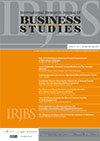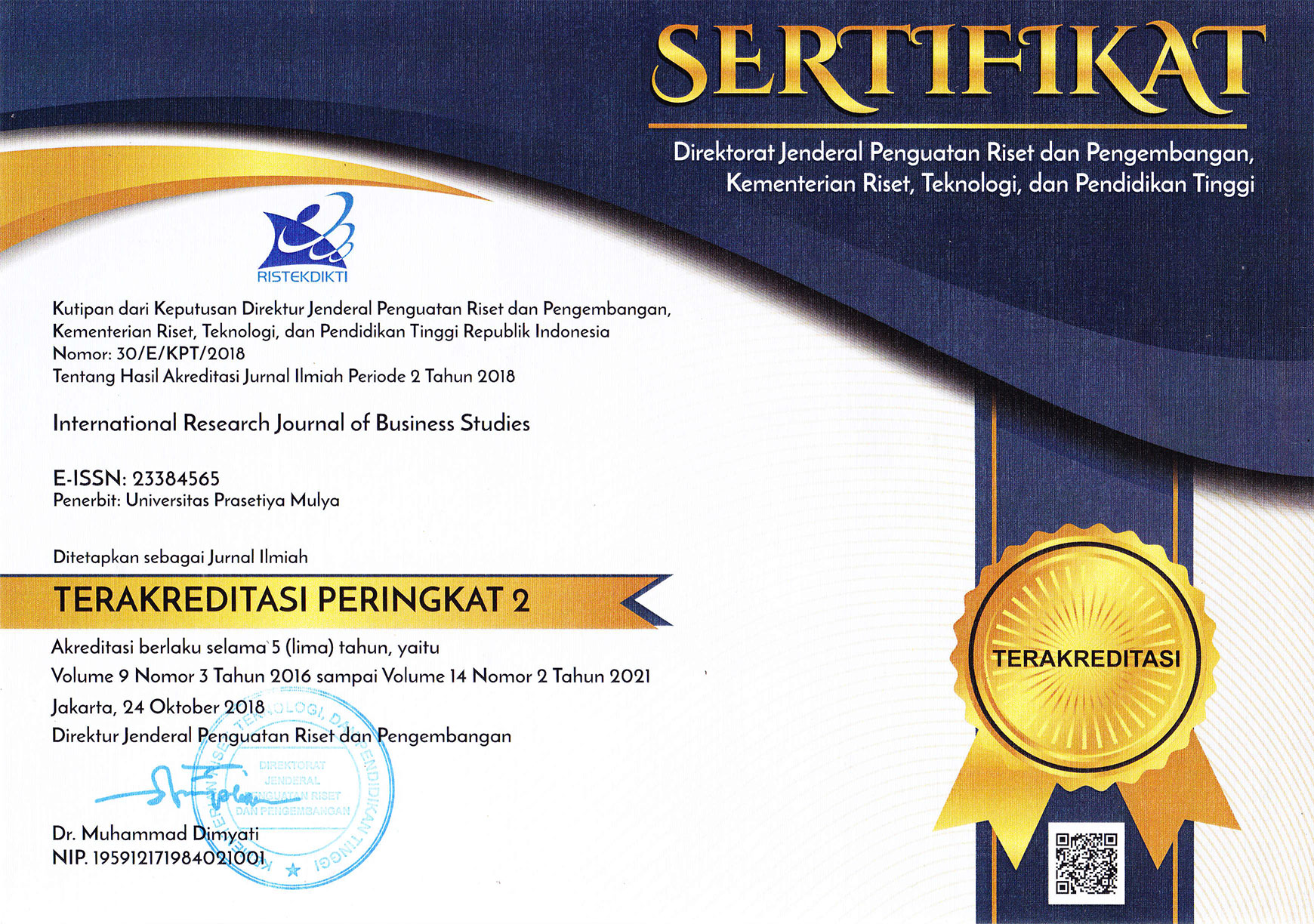The Impact of the Digital Divide on MSMEs’ Productivity In Indonesia
DOI:
https://doi.org/10.21632/irjbs.16.3.241-252Keywords:
Digital Divide, CT Adoption, MSMEs' Productivity, IndonesiaAbstract
Although the adoption of information and communication technology (ICT) has been rapid, gaps still exist regarding various areas of access to ICT among micro, small, and medium enterprises (MSMEs), which are the backbone of Indonesia’s economy. This study investigates how the digital divide factors increase productivity among MSMEs in Indonesia. Drawing on previous studies, the digital divide factors consist of material access, motivational access, skill access, and usage access. In this study, the logistic regression model is used with SUSENAS 2019 data from BPS. The study finds the significance of skill and usage access galvanize MSMEs’ enthusiasm to adopt the ICT platform in their business activities. Conversely, with weak significance of motivational and material access, this study recommends more extensive endeavors of the ICT infrastructure in boosting MSMEs’ productivity in the state of economic policy making in Indonesia.
References
Allen, K. E. (2015). Trade-offs in nature tourism. Ecology and Society, 20(1), 1–10.
Ameripour, A., Nicholson, B., & Newman, M. (2010). Conviviality of Internet Social Networks: An Exploratory Study of Internet Campaigns in Iran. JIT, 25, 244–257. https://doi.org/10.1057/jit.2010.14
Armey, L. E., & Hosman, L. (2016). The centrality of electricity to ICT use in low-income countries. Telecommunications Policy, 40(7), 617–627. https://doi.org/10.1016/j.telpol.2015.08.005
Badan Pusat Statistik. (2014). Gini Rasio 2002-2013. Retrieved August 3, 2021, from https://www.bps.go.id/indicator/23/98/9/gini-rasio.html
Badan Pusat Statistik. (2016). Tabel perkembangan UMKM pada periode 1997 - 2013. Retrieved May 13, 2021, from https://www.bps.go.id/statictable/2014/01/30/1322/tabel-perkembangan-umkm-pada-periode-1997--2013.html
Badan Pusat Statistik. (2017). Distribusi Persentase Penduduk (Persen), 2014-2016. Retrieved August 3, 2021, from https://www.bps.go.id/indicator/12/136/1/distribusi-persentase-penduduk.html
Cross, K. (2010). Why Iran’s Green Movement Faltered: The Limits of Information Technology in a Rentier State. SAIS Review of International Affairs, 30. https://doi.org/10.1353/sais.2010.0008
Das, K., Gryseels, M., Sudhir, P., & Tan, K. T. (2016). Unlocking Indonesia’s digital opportunity. Retrieved from https://www.mckinsey.com/~/media/McKinsey/Locations/Asia/Indonesia/Our%20Insights/Unlocking%20Indonesias%20digital%20opportunity/Unlocking_Indonesias_digital_opportunity.ashx
DiMaggio, P., & Hargittai, E. (2001). From the “Digital Divide” to “Digital Inequality”: Studying Internet Use as Penetration Increases. Princeton University, Woodrow Wilson School of Public and International Affairs, Center for Arts and Cultural Policy Studies., Working Papers.
Ghobadi, S., & Ghobadi, Z. (2015). How access gaps interact and shape digital divide: a cognitive investigation. Behaviour & Information Technology, 34(4), 330–340. https://doi.org/10.1080/0144929X.2013.833650
Gujarati, D., & Porter, D. (2008). Basic Econometrics (5th edition). New York: McGraw-Hill Education.
Hargittai, E. (2002). Second-Level Digital Divide: Differences in People’s Online Skills. First Monday, 7(4). https://doi.org/10.5210/fm.v7i4.942
Katz, J., & Rice, R. (2002). Social Consequences of Internet Use: Access, Involvement and Interaction. Cambridge, United States: MIT Press.
Kohler, U., & Kreuter, F. (2012). Data Analysis Using Stata, Third Edition (Third Edit). Stata Press.
Long, J. S., & Freese, J. (2001). Regression Models for Categorical Dependent Variables Using Stata. In Regression models for categorical dependent variables using Stata. Texas, United States.
Mason, S. M., & Hacker, K. (2003). APPLYING COMMUNICATION THEORY TO DIGITAL DIVIDE RESEARCH.
Ministry of Cooperatives and SMEs. (2019). Perkembangan data usaha Mikro, Kecil, Menengah (UMKM) dan Usaha Besar (UB) tahun 2018-2019. Retrieved July 3, 2021, from https://www.kemenkopukm.go.id/uploads/laporan/1617162002_SANDINGAN_DATA_UMKM_2018-2019.pdf
Mourougane, A. (2012). Promoting SME development in Indonesia. https://doi.org/10.1787/5k918xk464f7-en
Norris, P. (2003). The Worldwide Digital Divide: Information Poverty, the Internet and Development. In I mercati elettronici hanno reali prospettive? Milan: Franco Angeli.
NTIA. (1999). Falling through the Net III: Defining the digital divide. Washington DC: U.S. Department of Commerce.
OECD. (2001). Understanding the digital divide. Paris.
Onitsuka, K., Hidayat, A. R. R. T., & Huang, W. (2018). Challenges for the next level of digital divide in rural Indonesian communities. Electronic Journal of Information Systems in Developing Countries, 84(2), 1–25. https://doi.org/10.1002/isd2.12021
Pratomo, Y. (2020, February 27). Jokowi: Ekonomi digital Indonesia terbesar di Asia Tenggara. Kompas. Retrieved from https://tekno.kompas.com/read/2020/02/27/18010097/jokowi--ekonomi-digital-indonesia-terbesar-di-asia-tenggara
Reynolds, R. (2020). JanvanDijk. (2020). The digital divide. Cambridge, UK: Polity, 208 pp. £17.99 (paperback) (ISBN 9781509534456). Journal of the Association for Information Science and Technology, 72(1), 136–138. https://doi.org/10.1002/asi.24355
Riggins, F., & Dewan, S. (2005). The Digital Divide: Current and Future Research Directions. Journal of the Association for Information Systems, 6(12). https://doi.org/10.17705/1jais.00074
Sujarwoto, S., & Tampubolon, G. (2016). Spatial inequality and the Internet divide in Indonesia 2010–2012. Telecommunications Policy, 40(7), 602–616. https://doi.org/10.1016/j.telpol.2015.08.008
Sumolang, M. (2013). Peranan internet terhafap generasi muda di desa Tounelet kecamatan Langowan Barat. Journal Acta Diurna, 2(4), 1–16.
Susanto, A. (2017). Faktor-Faktor Yang Mempengaruhi Perilaku Penggunaan Internet Masyarakat Desa Pasar VI Kualanamu, Deli Serdang Sumatera Utara. Jurnal Penelitian Pos Dan Informatika, 5, 65. https://doi.org/10.17933/jppi.2015.0501005
The World Bank. (2013). World Development Indicators 2013. Washington DC. Retrieved from hhttp://data.worldbank.org/data-catalog/world-development-indicators
UNCTAD. (2019). Digital Economy Report 2019. Geneva.
UNESCAP. (2016). Asia-Pacific trade and investment report 2016. Retrieved from https://www.unescap.org/sites/default/d8files/aptir-2016-ch7.pdf
van Deursen, A. J., & van Dijk, J. A. (2014). The digital divide shifts to differences in usage. New Media & Society, 16(3), 507–526. https://doi.org/10.1177/1461444813487959
van Deursen, A. J., & van Dijk, J. A. (2009). Improving digital skills for the use of online public information and services. Government Information Quarterly, 26(2), 333–340. https://doi.org/10.1016/j.giq.2008.11.002
van Dijk, J. A. (2005). The Deepening Divide Inequality in the Information Society. Thousand Oaks California United States of America: Sage Publications.
van Dijk, J. A. (2006). Digital divide research, achievements and shortcomings. Poetics, 34(4–5), 221–235. https://doi.org/10.1016/j.poetic.2006.05.004
van Dijk, J. A. (2009). The Digital Divide in Europe. The Routledge Handbook of Internet Politics.
van Dijk, J. A. (2012). The evolution of the digital divide: The digital divide turns to inequality of skills and usage. Digital Enlightenment Yearbook 2012, 57–75. https://doi.org/10.3233/978-1-61499-057-4-57
van Dijk, J. A. (2013). Inequalities in the Network Society. In Digital Sociology (pp. 105–124). London: Palgrave Macmillan UK. https://doi.org/10.1057/9781137297792_8
Vidyattama, Y. (2010). A Search for Indonesia’s Regional Growth Determinants. Asean Economic Bulletin, 27, 281–294. https://doi.org/10.1355/ae27-3c
Downloads
Submitted
Published
How to Cite
Issue
Section
License
Copyright (c) 2024 Erica Novianti Lukas, Albert Hasudungan

This work is licensed under a Creative Commons Attribution-ShareAlike 4.0 International License.
Journal Author(s) Rights
For IRJBS to publish and disseminate research articles, we need publishing rights (transferred from the author(s) to the publisher). This is determined by a publishing agreement between the Author(s) and IRJBS. This agreement deals with the transfer or license of the copyright of publishing to IRJBS, while Authors still retain significant rights to use and share their own published articles. IRJBS supports the need for authors to share, disseminate and maximize the impact of their research and these rights, in any databases.
As a journal Author, you have rights to many uses of your article, including use by your employing institute or company. These Author rights can be exercised without the need to obtain specific permission. Authors publishing in IRJBS journals have comprehensive rights to use their works for teaching and scholarly purposes without needing to seek permission, including:
- use for classroom teaching by Author or Author's institution and presentation at a meeting or conference and distributing copies to attendees;
- use for internal training by the author's company;
- distribution to colleagues for their research use;
- use in a subsequent compilation of the author's works;
- inclusion in a thesis or dissertation;
- reuse of portions or extracts from the article in other works (with full acknowledgment of the final article);
- preparation of derivative works (other than commercial purposes) (with full acknowledgment of the final article);
- voluntary posting on open websites operated by the author or the author’s institution for scholarly purposes,
(But it should follow the open access license of Creative Common CC-by-SA License).
Authors/Readers/Third Parties can copy and redistribute the material in any medium or format, as well as remix, transform, and build upon the material for any purpose, even commercially. Still, they must give appropriate credit (the name of the creator and attribution parties (authors' detail information), a copyright notice, an open access license notice, a disclaimer notice, and a link to the material), provide a link to the license, and indicate if changes were made (Publisher indicates the modification of the material (if any) and retain an indication of previous modifications.
Authors/Readers/Third Parties can read, print and download, redistribute or republish the article (e.g. display in a repository), translate the article, download for text and data mining purposes, reuse portions or extracts from the article in other works, sell or re-use for commercial purposes, remix, transform, or build upon the material, they must distribute their contributions under the same license as the original Creative Commons Attribution-ShareAlike (CC BY-SA).
This work is licensed under a Creative Commons Attribution-ShareAlike 4.0 International License.








